Review GSM phone Motorola C261
Package
- Handset
- Battery
- Manual
- Charger
The company of Motorola is well known for its low-end solutions,
and very often the launch of this or that model determined the whole
development vector for years. A recent example is Motorola C350,
which is not the first phone with a touchscreen, and the screen
quality is not the best in its class. But the price/quality ratio
was so profitable that even today the device is still on the market
and keeps stable sales. The only similar example is Nokia 3310,
which also was a long-liver and sold in great quantities on the
market.
Now Motorola longs for making a model that would strengthen the
company's prevalence on the market, and will have a long life circle.
And it's quite reasonable to get a tested platform for such a device.
Well-known to everybody triplet platform served the basis (the first
models were v300, v500, v600). The second thing besides making a
successful product is to position it well on the market, give a
good price to it. A trusted way was used to solve the tusk. The
order was passed to a partner company. Besides producing several
models the partner accesses the hardware platform. Technologies
used by Motorola, which may give many profits if the company wants
to make own phone samples. The company of Compal is a Motorola's
partner in making the C261. This company has recommended itself
well as an ODM-maker. In fact, the assembly quality and the number
of denials seems acceptable for Motorola's level, and the price
is less, which brings profits and makes an end product cheaper.
In the С261's case Compal not just makes the model, besides, it
develops the software for it. This is some kind of a Compal's contribution
to the С261, and refusal from own software is dictated by the license
agreement. Considering the phone is a low-end solution, we do not
expect surprises from the soft. An obvious change is font-size,
not all the lines are shown on the screen, they are scrolled then.
In some items icons are changed and the rest all looks like a real
Motorola.
Motorola C261 is a sign model, as for the first time the principle
of "three meters" is used in a low-end phone. This Motorola's principle
can be shortly described as phone's recognizability in a user's
hands in a distance of three meters. We can easily assign this feature
to a high-end model, like Motorola RAZR. Later the company created
models for other segments as well following this principle. And
SLVR, L2, and L6 are much different from other models on the market.
However till today we couldn't say the principle was used for low-end
models, Motorola C115/C116 do even pretend on unique design. The
low-end segment has the main problem of artificially worsened material
quality to make the appearance plainer, and make a high demanding
user chose a more expensive handset. The margin of low-end models
is low, and thus giving expensive material to them is unprofitable,
as well as making them rememberable and attractive. And this very
model is a turning point: The market saturation made the company
offer an unordinary solution and change the appearance of a low-end
phone, as well as its functional saturation. It's not hard to guess
Motorola C261 will become the same product like the C350 was in
its time, other makers will orient on it and try to represent own
similar models.

The phone dimensions of 89x49x15.5 mm allow assigning the device
to "thin" solutions that Motorola promotes on the market. The weight
of 112 grams is caused by using Softtouch plastic (soft velvety
covering) and some metallic elements (in particular, the edging
of the middle of the device is metallic). In the very beginning
of the shipments only one body colour will be available. At the
same time, operator versions of the model will gladden with colour
variations and other names (C26x).



The keypad is plastic with projecting pleasant to touch buttons.
Working with it is pleasant, the backlighting is red and well seen
in various conditions, it doesn't irritate and gives some extra
charm to the model. In contrast to the triplets, there is no standard
miniUSB connector; only a side surface holds a connector for usual
earphones, headset and a charger (needle). The refusal from a standard
miniUSB connector is dictated by the fact the model is positioned
as a low-end phone only for calls. And by the way, the same reason
caused refusal from Bluetooth: the manufacturer decided on deactivating
the function in order to avoid competition with other company solutions.
Physically Bluetooth is present in the phone; however, it is closed
wit software means. Maybe in some time a modification of С261 supporting
Bluetooth will appear, or some skilled people will activate the
function.



There is a strap hole on the top. No side buttons are foreseen,
the camera is controlled only with usual buttons. The camera itself
is placed on the back, that is a VGA module known by other devices.
Due to the absence of communication means, transferring the data
is only possible vi a MMS. Video is not supported due to small memory
size.

The screen in the model equals the triplets - that is TFT with
the resolution of 128x160 pixels (Sharp). As for the screen quality
the model is one of the best on the market, it has no copies in
its class - and the screen is readable even in the sun.

The battery module is hidden behind a back cover. A 820 mAh Li-Ion
battery is placed here. As the manufacturer claims, it is capable
of up to 80 hours in the standby mode and up to 3 hours in the talk
model Averagely in Moscow the phone worked for about 3 days in case
of 45 minutes of talks. Full recharging takes 1.5 hours.

Menu
Only about 1.2 MB of memory are available to a user (from the very
beginning a part of 2 MB is reserved for content). The menu is organized
typically of Motorola, no changes. You can access the Main Menu
by pressing the Menu key centered into the navi button. The main
menu is traditionally presented with 9 icons; each of them uses
tips on the top of the screen. You can switch the main menu's appearance
to the list mode. Then everything will be presented with lists.
Half of the menu is presented with lists and half with icons (if
you use the appropriate menu look). The user can customize the order
of following for the icons in the main menu (or the items in list
view mode). The menu doesn't support fast number navigation, but
you can setup shortcuts for almost every menu item or function.
The navigational key can be assigned various actions to during the
stand by mode. Moreover, you can adjust it in order not have corresponding
icons on the screen but they would appear on pressure. Two soft-keys
can be bind to various actions as well, apart from the default ones.
With such menu personalization flexibility the lack of the fast
number navigation is not so noticeable.


Phonebook. Unlike other models the phone book
is of the old design here. Totally a bank of names can contain only
500 names with only one number or e-main address for each. At the
same time name grouping is preserved, then many numbers can be hidden
behind the same names. Traditionally any graphical file, own melody,
voice mark (up to 20) can be bound to a name. The reason of he cut
phonebook functions is the device belongs to the low-end segment.

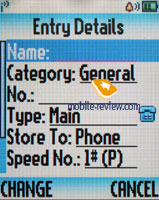
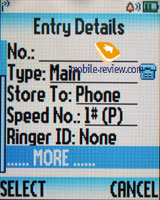

Messages. The default memory capacity for 100
SMS is provided; it may also vary depending on the software version.
As a rule, operator versions are limited by 40 messages. The device
works with EMS. Automatic cleaning of the whole message list should
be mentioned as an extra possibility; there is a list of templates.
Delivery report may be on permanently or switched on/off for a message.

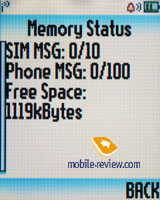


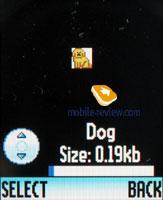
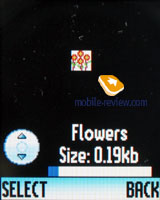
Working with MMS doesn't bring any inconvenience; everything is
simple and easily understandable. The messages can be attached with
pictures made by the built-in camera, sound files. The ten predefined
templates are really great, be sure to check them out, however,
they copy the previous models.

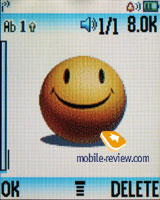
WAP. The phone has WAP-browser v2.0 and its possibilities
are standard so nothing special can be said. GPRS (class 8) is present,
the settings are rather simple, just follow your operator's instructions
and everything will be done in a matter of minutes.

Call log. The phone has a list of received calls;
it includes the missed ones as well, they are noticeable due an
absent tip in a list. You can also see the list of the 10 last dialed
numbers; you can access it by pressing the Call button. Everything
is rather simple and traditional, nothing special at all. Each entry
features the date and time as well as duration.

Also phone life time, calls of various types, connection time and
data seances are available from this menu.
Office applications. This menu features a whole
bunch of office applications including a Calculator. It's convenient,
the full digital keyboard is present on the screen and it reproduces
the real keyboard perfectly. The menu features memory options and
the unit converter. Stopwatch is also present.
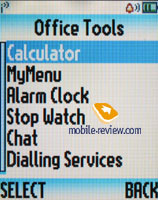


Shortcuts are located in the same menu. You can create shortcuts
not only for various menu sections, but for a definite wap-site
as well.
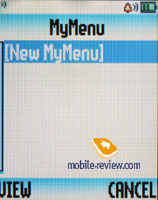
Alarm clock. You can create several alarm clocks and choose a custom
ring tone, name and volume, type of reoccurrence (daily, single
time) for each of them. This phone was designed for continuous,
that's why entering names and titles for the alarm clocks is required.
The alarm clocks are activated in one touch and tips ease working.

Games and applications. The phone supports Java
MIDP 2.0; all applications that are located in this menu are based
on this technology. The number of games and their title depend on
where the phone was bought. In the majority of cases you'll find
such games as Rebels, here called Space (space arcade), Soccer,
Crazy (a variant of Worms). Only over the air download of new games
is possible.





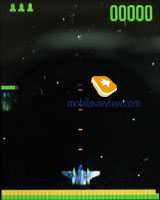
Multimedia. The phone doesn't support themes.
An end user can only change the menu colour..
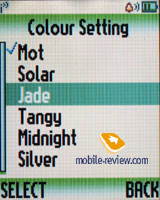
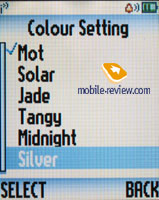




MotoMixer - original sound file editor that allows mixing the tracks.
You can play with it from time to time; the results may come out
rather unexpected and nice. However as the practice shows, these
sound editors are nothing more than a toy for most of the users,
only few of them take use tool seriously.
Sounds - information about all sound files located in the phone's
memory is stored here. Finally, they may be listened to.

Settings. Here you can setup all Display settings
including the color schemes.
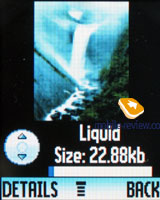


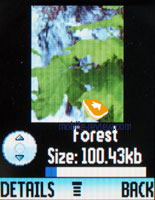
Ring tone type and notification mode (mixed mode, when the vibrating
alert works at the same time with the ring tone is present) is here
as well.
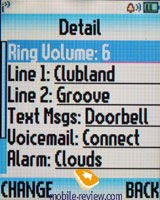
I don't think there is any need to describe the network and security
settings since they're all similar to any other phone.
Impressions
The integrated 32-tones polyphony sounds well and can be heard
in various conditions. You can set an mp3 files as a call melody,
but considering the memory size, we can say not many of such samples
are possible (2-4 at the most). The poser of vibra is average; however
the call is well-felt, mainly due to the phone thickness. Speakerphone
is realized well, and data transmission quality seemed acceptable.

In the beginning of November the C261 will be shipped onto the
market. The average price may form about 130-135 USD. Pleasant design
unusual for rival models and perfect screen crumble the high price
for a model with no synchronization means. Due to a little memory
size, entertainment capabilities turned very poor.
Considering material quality and unordinary design, we can suppose
the model will be demanded by a wide range of customers. The phone
sets new laths for budgetary solutions, and first that concerns
design and screen. Bluetooth is very possible to appear, due to
which the handset will become even more attractive. Now this model
should be treated as ideal for ones searching for a stylish cheap
with minimal functions, intended primarily for calls.
P.S. I'm sure our readers will feel an ambiguous feeling. And I'd
like to note future users of this phone are people, who only call,
though want to have a good, readable screen and attractive design.
In this very aspect the C261 seems the most successful.
Eldar Murtazin (eldar@mobile-review.com)
Translated by Maria Mitina (maria.mitina@mobile-review.com)
Published — 27 September 2005
Have something to add?! Write us... eldar@mobile-review.com
|

















































